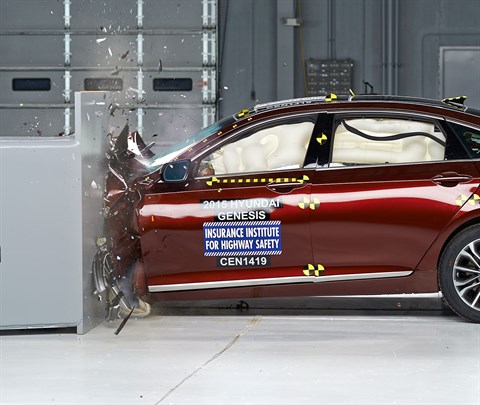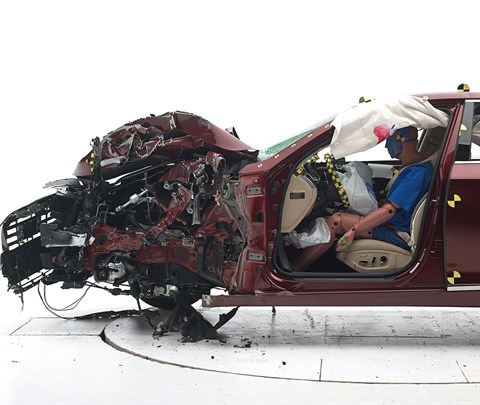Small overlap front: driver-side
Rating applies to 2015-16 models
Tested vehicle: 2015 Hyundai Genesis 3.8 4-door
The Hyundai Genesis was redesigned for the 2015 model year.
Hyundai created a new luxury division known as "Genesis" beginning with the 2017 model year. The Hyundai Genesis therefore was renamed the Genesis G80 in the same year. Small overlap frontal ratings carry over unchanged to the G80.
| Evaluation criteria | Rating |
|---|---|
| Structure and safety cage | |
| Driver injury measures | |
| Head/neck | |
| Chest | |
| Hip/thigh | |
| Lower leg/foot | |
| Driver restraints and dummy kinematics | |

Action shot taken during the driver-side small overlap frontal crash test.

The dummy's position in relation to the door frame, steering wheel, and instrument panel after the crash test indicates that the driver's survival space was maintained well.

The frontal and side curtain airbags worked well together to keep the head from coming close to any stiff structure or outside objects that could cause injury.

The driver's space was maintained well, and risk of injuries to the dummy's legs and feet was low.
Moderate overlap front: original test
Rating applies to 2015-16 models
Tested vehicle: 2015 Hyundai Genesis 5.0 4-door
The Hyundai Genesis was redesigned for the 2015 model year. Moderate overlap frontal ratings are assigned by the Institute based on a test conducted by Hyundai. (The car tested by Hyundai was designated as a 2014 model but was fully representative of the redesigned 2015 model.)
Hyundai created a new luxury division known as "Genesis" beginning with the 2017 model year. The Hyundai Genesis therefore was renamed the Genesis G80 in the same year. Moderate overlap frontal ratings carry over unchanged to the G80.
| Evaluation criteria | Rating |
|---|---|
| Overall evaluation | |
| Structure and safety cage | |
| Driver injury measures | |
| Head/neck | |
| Chest | |
| Leg/foot, left | |
| Leg/foot, right | |
| Driver restraints and dummy kinematics | |
Side: original test
Rating applies to 2015-16 models
Tested vehicle: 2015 Hyundai Genesis 5.0 4-door with standard front and rear head curtain airbags and standard front and rear seat-mounted torso airbags
The Hyundai Genesis was redesigned for the 2015 model year. Side ratings are assigned by the Institute based on a test conducted by Hyundai. (The car tested by Hyundai was designated as a 2014 model but was fully representative of the redesigned 2015 model.)
Hyundai created a new luxury division known as "Genesis" beginning with the 2017 model year. The Hyundai Genesis therefore was renamed the Genesis G80 in the same year. Side ratings carry over unchanged to the G80.
| Evaluation criteria | Rating |
|---|---|
| Overall evaluation | |
| Structure and safety cage | |
| Driver injury measures | |
| Head/neck | |
| Torso | |
| Pelvis/leg | |
| Driver head protection | |
| Rear passenger injury measures | |
| Head/neck | |
| Torso | |
| Pelvis/leg | |
| Rear passenger head protection | |
Roof strength
Rating applies to 2015-16 models
Tested vehicle: 2015 Hyundai Genesis 3.8 4-door
Rating applies to the 2015-16 models of the Hyundai Genesis and to the 2017 and later models of the Genesis G80.
| Overall evaluation | |
|---|---|
| Curb weight | 4,323 lbs |
| Peak force | 21,387 lbs |
| Strength-to-weight ratio | 4.95 |
Head restraints & seats
Seat type: Power leather seat
| Overall evaluation | |
|---|---|
| Dynamic rating | |
| Seat/head restraint geometry |
About the head restraint & seat test
Currently, IIHS tests apply only to front seats.
